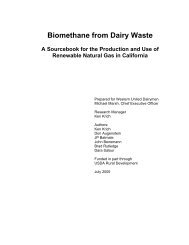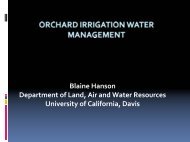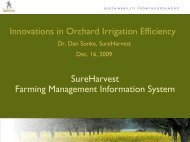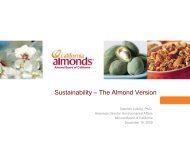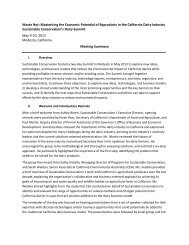THE PONDS PROJECT - Sustainable Conservation
THE PONDS PROJECT - Sustainable Conservation
THE PONDS PROJECT - Sustainable Conservation
You also want an ePaper? Increase the reach of your titles
YUMPU automatically turns print PDFs into web optimized ePapers that Google loves.
population. Under that scenario, the long-term February median flow could be an<br />
adequate bypass flow despite a CFII of more than 10 percent at a POI.<br />
To investigate this possibility, a qualified fishery biologist can survey (or<br />
otherwise quantify) spawning and rearing habitat within the watershed at points<br />
upstream and downstream of POI’s where CFII is greater than 10 percent. The<br />
results of such a survey would identify those spawning habitats most likely to be<br />
adversely affected by cumulative water diversions, and it would quantify<br />
available spawning habitats not likely to be adversely affected by cumulative<br />
water diversions.<br />
If credible site-specific biological data can demonstrate that minor reductions in<br />
available spawning habitat will not adversely affect salmonid populations, then it<br />
may be concluded that a diversion bypass flow equivalent to the February median<br />
flow poses no adverse affect to salmonid spawning habitat. To reach that<br />
conclusion, it would be necessary to provide biological data that demonstrates that<br />
the remaining available spawning habitat is clearly not limiting production of<br />
salmonids immediately downstream and in the vicinity of the diversion project.<br />
3. In situations where substantial amounts of potential spawning habitat in small<br />
watersheds are adversely affected by cumulative diversions, a qualified fishery<br />
biologist can assess the bypass flows needed to protect spawning habitat using the<br />
Instream Flow Incremental Methodology or other suitable methods for evaluating<br />
streamflows needed to protect fish habitat (Bovee 1982; EPRI 1986; Annear et al.<br />
2002). As discussed above, to ensure acceptance of the methodology and field<br />
study results, we recommend such studies be done in consultation with CDFG and<br />
NMFS.<br />
Bypass Flows for Anadromous Salmonid Passage<br />
When CFII is greater than 10 percent downstream from a diversion site, project<br />
proponents should evaluate impacts to upstream fish passage. High rates of water<br />
diversion can adversely affect fish passage by reducing stream depths in shallow riffles,<br />
steep gradient cascades, and artificial barriers. As flows recede, the flow at which<br />
passage opportunity becomes compromised is generally dependent on local hydraulic<br />
conditions and site specific features. The objectives of the fish passage assessment<br />
should be to identify flows that are adequate for upstream passage of adult salmonids and<br />
to determine the adequacy of the long-term February median flow for facilitating<br />
passage. If not, a higher minimum flow may be needed.<br />
Bjornn and Reiser (1991) discuss the issue of upstream migration of salmonids and<br />
approaches for evaluating the suitability of stream flows for successful passage.<br />
Effective passage flows are generally determined through site-specific studies that<br />
involve measurements at alternative flows. Thompson (1972) describes one approach for<br />
identifying suitable passage flows based on empirical measurements at transects across<br />
57



